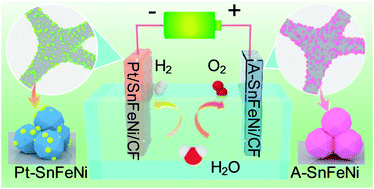In situ growth of free-standing perovskite hydroxide electrocatalysts for efficient overall water splitting†
Abstract
Water splitting is a promising way to convert intermittent energy such as wind and solar to clean and renewable hydrogen fuel. The low efficiency of the oxygen evolution reaction (OER) and hydrogen evolution reaction (HER) is often considered as a bottleneck in overall water splitting. Herein, free-standing electrocatalysts consisting of perovskite hydroxide (SnFeNi) on self-supported Cu foam (CF) are demonstrated for overall water splitting. We developed A-SnFeNi/CF as an OER electrocatalyst by in situ growing perovskite hydroxide particles on CF and subsequently electrochemically activating them. The A-SnFeNi/CF catalyst exhibits an excellent OER performance with a low overpotential of 385 mV at 100 mA cm−2, which can be attributed to the fast electron transfer stemming from the intimate contact between the perovskite hydroxide particles and CF. By depositing ultrafine Pt nanoparticles (0.42 wt% loading) on CF, Pt-SnFeNi/CF presents a lower overpotential of 20 mV at 10 mA cm−2 than commercial Pt/C for the HER, owing to the synergy of Pt nanoparticles with perovskite hydroxides. Moreover, the water splitting device constructed with the free-standing SnFeNi/CF-based electrodes only needs 1.57 V to achieve a current density of 10 mA cm−2, 50 mV lower than that of a commercial RuO2/CF‖Pt/C/CF couple.



 Please wait while we load your content...
Please wait while we load your content...